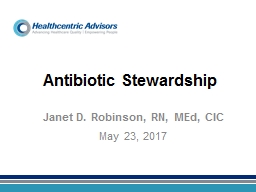

May 23 2017 No Conflict of Interest This confirms that there were not relevant conflicts of interest reported from either todays speakers or planning members of this learning activity ID: 1033659
Download Presentation The PPT/PDF document "Antibiotic Stewardship Janet D. Robinson..." is the property of its rightful owner. Permission is granted to download and print the materials on this web site for personal, non-commercial use only, and to display it on your personal computer provided you do not modify the materials and that you retain all copyright notices contained in the materials. By downloading content from our website, you accept the terms of this agreement.
1. Antibiotic StewardshipJanet D. Robinson, RN, MEd, CICMay 23, 2017
2. No Conflict of Interest This confirms that there were not relevant conflicts of interest reported from either today’s speakers or planning members of this learning activity.
3. Common long-term care scenarios in which antibiotics are not needed** Positive urine culture in the absence of symptoms (cloudy or smelly urine should not be considered symptoms) Upper respiratory infection (common cold with or without fever, bronchitis, sinusitis not meeting clinical criteria for antibiotics) Abnormal chest x-ray without signs/symptoms of respiratory infection Positive wound culture in the absence of cellulitis, abscess or necrosis Diarrhea in the absence of positive C. diff toxin assay Positive C. diff test in a patient whom symptoms have resolved and therapy completed Predictable mental status fluctuations in a patient with dementia ** Contents of this slide from the Massachusetts DPH webinar- Introduction to Antimicrobial Stewardship in Long Term Care: What is Antimicrobial Stewardship and Why is it Important? (February 28th, 2017) Used with permission from Shira Doron, MD and Kirthana Beaulac, PharmD.
4. Objectives
5. Your Questions/ConcernsDo I need to be certified in antibiotic stewardship?What is proper way to dispose of antibiotics?What do we need to have in place right now?Education & tools for staff (including physicians) to understand concept and implement Prescribers not on board Tracking & Tools Numbers, antibiotic days, antibiotic usageBest practice tools, data presentation, QAPI report
6. CMS Reform of Requirements for Long-Term Care Facilities 483.80 Infection control(a) Infection prevention and control program(3) An antibiotic stewardship program that includes antibiotic use protocols and a system to monitor antibiotic use. “due date” – November 28, 2017
7. The following 7 slides contain material excerpted and adapted from a CMS presentation
8. CMS Presentation – January 2017Infection ControlA Talk about the Changes and Expectations for Long Term CareSharon Roberson, RNSharon.Roberson@cms.hhs.govSurvey & Certification Technical LeadNortheast Division of Survey & CertificationDivision of Quality Improvement
9. Antibiotic Stewardship – Team SportPrescribersPharmacistsLab personnelClinical staffResidents & families
10. Antibiotic Program GoalsEnsure only necessary prescriptionsEnsure appropriate utilizationDecrease adverse consequencesAllergic responseDrug interactionsClostridium difficile Promote responsible use
11. Inappropriate UseUnnecessary prescriptionsBroad spectrum rather than narrowAntibiotic not aligned with microbiology resultsIncorrect dosageDuration too long
12. Program StrategiesAdministrative support & dedicated personnelMonitor antibiotic resistance & usage patternsEducation – available resources & guidelinesEstablish local treatment protocols facility widewww.cdc.gov/longtermcare/prevention/antibiotic-stewardship.html
13. Program ComponentsTarget areas where antibiotics are most often over-prescribed Assessment and bench markingChallenge use with non-specific symptomsEducation and communicationTransitions of care, families, Appropriate responses to cultures- timely and appropriate use
14. Antibiotic Use/PrescribingDrug – Dose - DurationCulture resultsStart & stop dates/monitoringDocumentationCommunicationSBAR, facility designed tools/pathways
15. CommunicationTeamwork – collaboration & cooperationChallenge accountabilityFacility leadership and corporate supportResident & family education & cooperation(End of material excerpted and adapted from CMS webinar )
16. Resourceshttps://www.cdc.gov/longtermcare/prevention/antibiotic-stewardship.htmlhttps://www.ahrq.gov/nhguide/index.html (Agency for Healthcare Research & Quality)
17. Additions to the CDC Core Elements Appendix A: Policy and Practice Actions to Improve Antibiotic UseAppendix B: Measures of Antibiotic Prescribing, Use and Outcomes
18.
19. Nursing Home Antimicrobial Stewardship GuideFour toolkitsImplement, Monitor, and Sustain an Antimicrobial Stewardship ProgramDetermine Whether It Is Necessary To Treat a Potential Infection With AntibioticsHelp Prescribing Clinicians Choose the Right AntibioticEducate and Engage Residents and Family MembersAHRQ
20. Determine Whether It Is Necessary To Treat a Potential Infection With AntibioticsThe Suspected UTI SBAR toolkit provides guidance and tools for improving the use of antibiotics for urinary tract infections (UTIs) in nursing home residents based on the Situation, Background, Assessment, and Request (SBAR) format. It is the simplest toolkit to adopt.The Communicating and Decisionmaking for Four Infections toolkit provides guidance and tools for improving the use of antibiotics in the four types of infections where antibiotics are most frequently used in nursing homes: UTIs, lower respiratory infections, skin and soft tissue infections, and gastrointestinal infections. This toolkit may be used instead of the Suspected UTI SBAR toolkit to target additional situations in which antibiotics may be overused.The Minimum Criteria for Common Infections toolkit provides guidance and tools—including a Web app with a diagnostic guidance tool for prescribing clinicians—to improve the use of antibiotics for three common infections: UTIs, lower respiratory infections, and skin and soft tissue infections. Nursing homes can use this toolkit to target these common infections when nursing home leaders want to use a model similar to the Suspected UTI SBAR toolkit.AHRQ
21. Suspected UTI SBAR form A Clinician Letter: A template for a letter to prescribing clinicians explaining the form and its rationale Not All “Infections” Need Antibiotics: A handout for nurses describing the form Urinalysis and UTIs: Improving Care provides training modules about the form for nursing staffAHRQ The Suspected UTI SBAR Toolkit
22. Table 2. How Toolkits Apply to QAPI or State Survey RequirementsChoosing the Right Toolkit. Content last reviewed October 2016. Agency for Healthcare Research and Quality, Rockville, MD. http://www.ahrq.gov/nhguide/about/choosing-the-right-toolkit.html (excerpt) ToolkitsFocus on Quality ImprovementOutlines Policies and ProceduresMonitoring and FeedbackPerformance Improvement Projects Evidence- Or Best Practice-BasedResident EngagementStart an Antimicrobial Stewardship ProgramXX X Monitor and Sustain StewardshipX X X Suspected UTI SBAR FormX XX
23. Your Questions/ConcernsDo I need to be certified in antibiotic stewardship?What is proper way to dispose of antibiotics?What do we need to have in place right now?Education & tools for staff (including physicians) to understand concept and implement Prescribers not on board Tracking & Tools Numbers, antibiotic days, antibiotic usageBest practice tools, data presentation, QAPI report